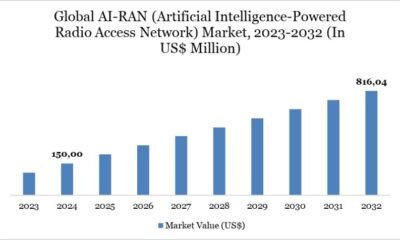AI Research
Artificial Intelligence in E-Commerce Market Analysis 2025:

Latest Report, titled Artificial Intelligence in E Commerce Market Trends, Share, Size, Growth, Opportunity and Forecast 2025-2032, by Coherent Market Insights offers a comprehensive analysis of the industry, which comprises insights on the market analysis. The report also includes competitor and regional analysis, and contemporary advancements in the market.
The report features a comprehensive table of contents, figures, tables, and charts, as well as insightful analysis. The Artificial Intelligence in E Commerce market has been expanding significantly in recent years, driven by various key factors like increased demand for its products, expanding customer base, and technological advancements. This report provides a comprehensive analysis of the Artificial Intelligence in E Commerce market, including market size, trends, drivers and constraints, competitive aspects, and prospects for future growth.
➤ Get a Sample Copy of This Report: https://www.coherentmarketinsights.com/insight/request-sample/7394
The report sheds light on the competitive landscape, segmentation, geographical expansion, revenue, production, and consumption growth of the Artificial Intelligence in E Commerce market. The Artificial Intelligence in E Commerce Market Size, Growth Analysis, Industry Trend, and Forecast provides details of the factors influencing the business scope. This report provides future products, joint ventures, marketing strategy, developments, mergers and acquisitions, marketing, promotions, revenue, import, export, CAGR values, the industry as a whole, and the particular competitors faced are also studied in the large-scale market.
➤ Overview and Scope of the Report:
This report is centred around the Artificial Intelligence in E Commerce in the worldwide market, with a specific focus on North America, Europe, Asia-Pacific, South America, Middle East, and Africa. The report classifies the market by manufacturers, regions, type, and application. It presents a comprehensive view of the current market situation, encompassing historical and projected market size in terms of value and volume. Additionally, the report covers technological advancements and considers macroeconomic and governing factors influencing the market.
➤ Key Players Covered In This Report:
• Amazon.comInc.
• AntVoice SAS
• Appier Inc.
• Celect Inc.
• Cortexica Vision Systems Ltd.
• Crobox B.V.
• Deepomatic SAS
• Dynamic Yield Ltd.
• EversightInc.
• Granify Inc.
• LivePerson Inc.
• Manthan Software Services Pvt. Ltd.
• PayPalInc.
• ReflektionInc.
• and Riskified
➤ Comprehensive segmentation and classification of the report:
By Product Type:
• Emergency Air Transport
• Medical Air Transport
• Hospital Transfer Services
By Application:
• Emergency Medical Services
• Inter-facility Transport
• Organ Transport
By End User:
• Hospitals
• Emergency Services
• Government Agencies
By Region:
• North America
• Europe
• Asia Pacific
• Rest of World
This Report includes a company overview, company financials, revenue generated, market potential, investment in research and development, new market initiatives, production sites and facilities, company strengths and weaknesses, product launch, product trials pipelines, product approvals, patents, product width and breath, application dominance, technology lifeline curve. The data points provided are only related to the company’s focus related to Artificial Intelligence in E Commerce markets. Leading global Artificial Intelligence in E Commerce market players and manufacturers are studied to give a brief idea about competitions.
➤ Key Opportunities:
The report examines the key opportunities in the Artificial Intelligence in E Commerce Market and identifies the factors that are driving and will continue to drive the industry’s growth. It takes into account past growth patterns, growth drivers, as well as current and future trends.
➤ Get discount on Purchase report : https://www.coherentmarketinsights.com/insight/buy-now/7394
➤ Highlights of Our Report:
•Extensive Market Analysis: A deep dive into the manufacturing capabilities, production volumes, and technological innovations within the Artificial Intelligence in E Commerce Market.
• Corporate Insights: An in-depth review of company profiles, spotlighting major players and their strategic manoeuvres in the market’s competitive arena.
•Consumption Trends: A detailed analysis of consumption patterns, offering insight into current demand dynamics and consumer preferences.
•Segmentation Details: An exhaustive breakdown of end-user segments, depicting the market’s spread across various applications and industries.
• Pricing Evaluation: A study of pricing structures and the elements influencing market pricing strategies.
• Future Outlook: Predictive insights into market trends, growth prospects, and potential challenges ahead.
➤ Why Should You Obtain This Report?
• Statistical Advantage: Gain access to vital historical data and projections for the Artificial Intelligence in E Commerce Market, arming you with key statistics.
• Competitive Landscape Mapping: Discover and analyze the roles of market players, providing a panoramic view of the competitive scene.
• Insight into Demand Dynamics: Obtain comprehensive information on demand characteristics, uncovering market consumption trends and growth avenues.
• Identification of Market Opportunities: Astutely recognize market potential, aiding stakeholders in making informed strategic decisions.
➤ Get discount on Purchase report : https://www.coherentmarketinsights.com/insight/buy-now/7394
➤ Questions Answered by the Report:
(1) Which are the dominant players of the Artificial Intelligence in E Commerce Market?
(2) What will be the size of the Artificial Intelligence in E Commerce Market in the coming years?
(3) Which segment will lead the Artificial Intelligence in E Commerce Market?
(4) How will the market development trends change in the next five years?
(5) What is the nature of the competitive landscape of the Artificial Intelligence in E Commerce Market?
(6) What are the go-to strategies adopted in the Artificial Intelligence in E Commerce Market?
Author of this marketing PR:
Alice Mutum is a seasoned senior content editor at Coherent Market Insights, leveraging extensive expertise gained from Openpr her previous role as a content writer. With seven years in content development, Alice masterfully employs SEO best practices and cutting-edge digital marketing strategies to craft high-ranking, impactful content. As an editor, she meticulously ensures flawless grammar and punctuation, precise data accuracy, and perfect alignment with audience needs in every research report. Alice’s dedication to excellence and her strategic approach to content make her an invaluable asset in the world of market insights.
About Us:
Coherent Market Insights leads into data and analytics, audience measurement, consumer behaviors, and market trend analysis. From shorter dispatch to in-depth insights, CMI has exceled in offering research, analytics, and consumer-focused shifts for nearly a decade. With cutting-edge syndicated tools and custom-made research services, we empower businesses to move in the direction of growth. We are multifunctional in our work scope and have 450+ seasoned consultants, analysts, and researchers across 26+ industries spread out in 32+ countries.
Contact Us:
Mr. Shah
Coherent Market Insights
533 Airport Boulevard,
Suite 400, Burlingame,
CA 94010, United States
US: + 12524771362
UK: +442039578553
AUS: +61-8-7924-7805
India: +91-848-285-0837
This release was published on openPR.
AI Research
Alberta Follows Up Its Artificial Intelligence Data Centre Strategy with a Levy Framework

Alberta is introducing a levy framework for data centres powering artificial intelligence technologies, the Province recently announced.
Effective by the end of 2026, a 2% levy on computer hardware will apply to grid-connected data centres of 75 megawatts or greater, according to a statement from Alberta.
The levy will be fully offset against provincial corporate income taxes, the government says. Once a data centre becomes profitable and pays corporate income tax in Alberta, the levy will not result in any additional tax burden.
Data centres of 75MW or greater will be recognized as designated industrial properties, with property values assessed by the province. Land and buildings associated with data centres will be subject to municipal taxation.
The framework was forged through a six-week consultation with industry stakeholders, according to Nate Glubish, Minister of Technology and Innovation.
“Alberta’s government has a duty to ensure Albertans receive a fair deal from data centre investments,” the provincial minister remarked. “This approach strikes a balance that we believe is fair to industry and Albertans, while protecting Alberta’s competitive advantage.”
Glubish added that the Alberta government is also exploring other options. This includes a payment in lieu of taxes program that would allow companies to make predictable annual payments instead of fluctuating levy amounts, as well as a deferral program to ease cash-flow pressures during construction and early years of operation.
“After working closely with industry, we’re introducing a fair, predictable levy that ensures data centres pay their share for the infrastructure and services that support them,” commented Nate Horner, Minister of Finance.
“This approach provides stability for businesses while generating new revenue to support Alberta’s future,” he posits.
The decision builds on the Alberta Artificial Intelligence Data Centre Strategy, introduced in 2024.
The strategy aims to capture a larger share of the global AI data centre market, which is expected to exceed $820 billion by 2030 as Alberta becomes a data centre powerhouse within Canada.
However, the Province’s tactics have not gone uncriticized.
AI Research
Reimagining clinical AI: from clickstreams to clinical insights with EHR use metadata

Harnessing EHR data for health research | Nature Medicine. https://www.nature.com/articles/s41591-024-03074-8.
Acosta, J. N., Falcone, G. J., Rajpurkar, P. & Topol, E. J. Multimodal biomedical AI. Nat. Med. 28, 1773–1784 (2022).
Adler-Milstein, J. et al. Meeting the Moment: Addressing Barriers and Facilitating Clinical Adoption of Artificial Intelligence in Medical Diagnosis. NAM Perspect. https://doi.org/10.31478/202209c. (2022)
Aquino, Y. S. J. et al. Utopia versus dystopia: Professional perspectives on the impact of healthcare artificial intelligence on clinical roles and skills. Int. J. Med. Inf. 169, 104903 (2023).
Pavuluri, S., Sangal, R., Sather, J. & Taylor, R. A. Balancing act: the complex role of artificial intelligence in addressing burnout and healthcare workforce dynamics. BMJ Health Care Inf. 31, e101120 (2024).
Rule, A. et al. Guidance for reporting analyses of metadata on electronic health record use. J. Am. Med. Inform. Assoc.31, 784–789 (2023).
Adler-Milstein, J., Adelman, J. S., Tai-Seale, M., Patel, V. L. & Dymek, C. EHR audit logs: A new goldmine for health services research?. J. Biomed. Inform. 101, 103343 (2020).
Kannampallil, T. & Adler-Milstein, J. Using electronic health record audit log data for research: insights from early efforts. J. Am. Med. Inform. Assoc. 30, 167–171 (2023).
Rule, A., Melnick, E. R. & Apathy, N. C. Using event logs to observe interactions with electronic health records: an updated scoping review shows increasing use of vendor-derived measures. J. Am. Med. Inform. Assoc. 30, 144–154 (2023).
Rule, A., Chiang, M. F. & Hribar, M. R. Using electronic health record audit logs to study clinical activity: a systematic review of aims, measures, and methods. J. Am. Med. Inform. Assoc.27, 480–490 (2020).
Physician time spent using the electronic health record during outpatient encounters: a descriptive study. Ann Intern. Med 172, No 3. https://www.acpjournals.org/doi/10.7326/M18-3684.
Rotenstein, L. S., Holmgren, A. J., Downing, N. L. & Bates, D. W. Differences in total and after-hours electronic health record time across ambulatory specialties. JAMA Intern. Med. 181, 863–865 (2021).
Tai-Seale, M. et al. Association of physician burnout with perceived EHR work stress and potentially actionable factors. J. Am. Med. Inform. Assoc. 30, 1665–1672 (2023).
Chen, Y. et al. Modeling care team structures in the neonatal intensive care unit through network analysis of EHR Audit Logs. Methods Inf. Med. 58, 109–123 (2019).
Yakusheva, O. et al. An electronic health record metadata-mining approach to identifying patient-level interprofessional clinician teams in the intensive care unit. J. Am. Med. Inform. Assoc. 32, 426–434 (2025).
Chen, Y., Patel, M. B., McNaughton, C. D. & Malin, B. A. Interaction patterns of trauma providers are associated with length of stay. J. Am. Med. Inform. Assoc.25, 790–799 (2018).
Lou, S. S. et al. Effect of clinician attention switching on workload and wrong-patient errors. Br. J. Anaesth. 129, e22–e24 (2022).
Rose, C. et al. Team is brain: leveraging EHR audit log data for new insights into acute care processes. J. Am. Med. Inform. Assoc. 30, 8–15 (2023).
Melnick, E. R. et al. Analysis of electronic health record use and clinical productivity and their association with physician turnover. JAMA Netw. Open 4, e2128790 (2021).
Tran, B., Lenhart, A., Ross, R. & Dorr, D. A. Burnout and EHR use among academic primary care physicians with varied clinical workloads. AMIA Summits Transl. Sci. Proc. 2019, 136–144 (2019).
Rossetti, S. C. et al. Real-time surveillance system for patient deterioration: a pragmatic cluster-randomized controlled trial. Nat. Med. 1–8. https://doi.org/10.1038/s41591-025-03609-7. (2025)
Rossetti, S. C. et al. Healthcare process modeling to phenotype clinician behaviors for exploiting the signal gain of clinical expertise (HPM-ExpertSignals): Development and evaluation of a conceptual framework. J. Am. Med. Inform. Assoc.28, 1242–1251 (2021).
Zhang, X., Yan, C., Malin, B. A., Patel, M. B. & Chen, Y. Predicting next-day discharge via electronic health record access logs. J. Am. Med. Inform. Assoc.28, 2670–2680 (2021).
Bhaskhar, N., Ip, W., Chen, J. H. & Rubin, D. L. Clinical outcome prediction using observational supervision with electronic health records and audit logs. J. Biomed. Inform. 147, 104522 (2023).
Zhang, X. et al. Optimizing large language models for discharge prediction: best practices in leveraging electronic health record audit logs. AMIA Annu. Symp. Proc. 2024, 1323–1331 (2025).
Kim, S., Warner, B. C., Lew, D., Lou, S. S. & Kannampallil, T. Measuring cognitive effort using tabular transformer-based language models of electronic health record-based audit log action sequences. J. Am. Med. Inform. Assoc.31, 2228–2235 (2024).
Rossetti, S. C. et al. Leveraging clinical expertise as a feature – not an outcome – of predictive models: evaluation of an early warning system use case. Amia. Annu. Symp. Proc. 2019, 323–332 (2020).
Duggan, M. J. et al. Clinician experiences with ambient scribe technology to assist with documentation burden and efficiency. JAMA Netw. Open 8, e2460637 (2025).
Garcia, P. et al. Artificial intelligence–generated draft replies to patient inbox messages. JAMA Netw. Open 7, e243201 (2024).
Sinsky, C. A., Rotenstein, L., Holmgren, A. J. & Apathy, N. C. The number of patient scheduled hours resulting in a 40-hour work week by physician specialty and setting: a cross-sectional study using electronic health record event log data. J. Am. Med. Inform. Assoc. 32, 235–240 (2025).
Holmgren, A. J., Sinsky, C. A., Rotenstein, L. & Apathy, N. C. National comparison of ambulatory physician electronic health record use across specialties. J. Gen. Intern. Med. 39, 2868–2870 (2024).
Rotenstein, L. et al. Virtual scribes and physician time spent on electronic health records. JAMA Netw. Open 7, e2413140 (2024).
Rotenstein, L. S. et al. Association of primary care physicians’ Electronic Inbox activity patterns with patients’ likelihood to recommend the physician. J. Gen. Intern. Med. 39, 150–152 (2024).
Li, H. et al. Quantifying EHR and policy factors associated with the gender productivity gap in ambulatory, general internal medicine. J. Gen. Intern. Med. 39, 557–565 (2024).
Jay Holmgren, A., Steitz, B., Lou, S. & Apathy, N. Using Electronic Health Record Metadata to Understand Clinician Work and Behavior. In Reengineering Clinical Workflow in the Digital and AI Era: Toward Safer and More Efficient Care (eds. Zheng, K., Westbrook, J. & Patel, V. L.) 299–317 (Springer Nature Switzerland, Cham, https://doi.org/10.1007/978-3-031-82971-0_15. 2025).
Rotenstein, L. & Jay Holmgren, A. COVID exacerbated the gender disparity in physician electronic health record inbox burden. J. Am. Med. Inform. Assoc. 30, 1720–1724 (2023).
Gupta, K. et al. Differences in ambulatory EHR use patterns for male vs. female physicians. Catal. Carryover 5, (2019).
Rotenstein, L. S. et al. System-level factors and time spent on electronic health records by primary care physicians. JAMA Netw. Open 6, e2344713 (2023).
Holmgren, A. J., Thombley, R., Sinsky, C. A. & Adler-Milstein, J. Changes in physician electronic health record use with the expansion of telemedicine. JAMA Intern. Med. 183, 1357–1365 (2023).
Tawfik, D. et al. Emerging domains for measuring health care delivery with electronic health record metadata. J. Med. Internet Res. 27, e64721 (2025).
Yan, C. et al. Differences in health professionals’ engagement with electronic health records based on inpatient race and ethnicity. JAMA Netw. Open 6, e2336383 (2023).
Cox, M. L. et al. Documenting or operating: where is time spent in general surgery residency?. J. Surg. Educ. 75, e97–e106 (2018).
Read-Brown, S. et al. Time requirements for electronic health record use in an Academic Ophthalmology Center. JAMA Ophthalmol. 135, 1250–1257 (2017).
Dziorny, A. C. et al. Automatic detection of front-line clinician hospital shifts: a novel use of electronic health record timestamp data. Appl. Clin. Inform. 10, 28–37 (2019).
Hribar, M. R. et al. Secondary use of EHR timestamp data: validation and application for workflow optimization. Amia. Annu. Symp. Proc. 2015, 1909–1917 (2015).
Hribar, M. R. et al. Secondary use of electronic health record data for clinical workflow analysis. J. Am. Med. Inform. Assoc. JAMIA 25, 40–46 (2018).
Sinsky, C. A. et al. Metrics for assessing physician activity using electronic health record log data. J. Am. Med. Inform. Assoc. 27, 639–643 (2020).
Avdagovska, M. et al. Exploring the impact of in basket metrics on the adoption of a new electronic health record system among specialists in a tertiary hospital in alberta: descriptive study. J. Med. Internet Res. 26, e53122 (2024).
Akbar, F. et al. Physicians’ electronic inbox work patterns and factors associated with high inbox work duration. J. Am. Med. Inform. Assoc. 28, 923–930 (2021).
Arndt, B. G. et al. Tethered to the EHR: Primary care physician workload assessment using EHR event log data and time-motion observations. Ann. Fam. Med. 15, 419–426 (2017).
Amroze, A. et al. Use of electronic health record access and audit logs to identify physician actions following noninterruptive alert opening: descriptive study. JMIR Med. Inform. 7, e12650 (2019).
Cutrona, S. L. et al. Primary care providers’ opening of time-sensitive alerts sent to commercial electronic health record inBaskets. J. Gen. Intern. Med. 32, 1210–1219 (2017).
Rumlow, Z. et al. The impact of diagnosis-specific plan templates on admission note writing time: a quality improvement initiative. J. Grad. Med. Educ. 16, 581–587 (2024).
Nguyen, O. T. et al. Primary care physicians’ electronic health record proficiency and efficiency behaviors and time interacting with electronic health records: a quantile regression analysis. J. Am. Med. Inform. Assoc. JAMIA 29, 461–471 (2021).
Chen, B. et al. Mining tasks and task characteristics from electronic health record audit logs with unsupervised machine learning. J. Am. Med. Inform. Assoc. 28, 1168–1177 (2021).
Lou, S. S., Liu, H., Harford, D., Lu, C. & Kannampallil, T. Characterizing the macrostructure of electronic health record work using raw audit logs: an unsupervised action embeddings approach. J. Am. Med. Inform. Assoc. 30, 539–544 (2023).
Tiase, V. L., Sward, K. A. & Facelli, J. C. A scalable and extensible logical data model of electronic health Record Audit Logs for Temporal Data Mining (RNteract): model conceptualization and formulation. JMIR Nurs. 7, e55793 (2024).
Zhang, X., Zhao, Y., Yan, C., Derr, T. & Chen, Y. Inferring EHR utilization workflows through audit logs. Amia. Annu. Symp. Proc. 2022, 1247–1256 (2023).
Chen, Y., Adler-Milstein, J. & Sinsky, C. Measuring and maximizing undivided attention in the context of electronic health records. Appl. Clin. Inform. https://doi.org/10.1055/a-1892-1437. (2022)
Moy, A. J. et al. Characterizing multitasking and workflow fragmentation in electronic health records among emergency department clinicians: using time-motion data to understand documentation burden. Appl. Clin. Inform. 12, 1002–1013 (2021).
Jones, B., Zhang, X., Malin, B. A. & Chen, Y. Learning tasks of pediatric providers from electronic health record audit logs. Amia. Annu. Symp. Proc. 2020, 612–618 (2021).
Li, P. et al. Measuring collaboration through concurrent electronic health record usage: network analysis study. JMIR Med. Inform. 9, e28998 (2021).
Mannering, H. et al. Assessing neonatal intensive care unit structures and outcomes before and during the COVID-19 pandemic: network analysis study. J. Med. Internet Res. 23, e27261 (2021).
Chen, Y., Yan, C. & Patel, M. B. Network analysis subtleties in ICU structures and outcomes. Am. J. Respir. Crit. Care Med. 202, 1606–1607 (2020).
Chen, Y., Lorenzi, N. M., Sandberg, W. S., Wolgast, K. & Malin, B. A. Identifying collaborative care teams through electronic medical record utilization patterns. J. Am. Med. Inform. Assoc. JAMIA 24, e111–e120 (2017).
Yan, C. et al. Collaboration structures in COVID-19 critical care: retrospective network analysis study. JMIR Hum. Factors 8, e25724 (2021).
Kelly Costa, D., Liu, H., Boltey, E. M. & Yakusheva, O. The structure of critical care nursing teams and patient outcomes: a network analysis. Am. J. Respir. Crit. Care Med. 201, 483–485 (2020).
Kim, C. et al. Provider Networks in the Neonatal Intensive Care Unit Associate with Length of Stay. In 2019 IEEE 5th International Conference on Collaboration and Internet Computing (CIC) 127–134. https://doi.org/10.1109/CIC48465.2019.00024. (2019)
Apathy, N. C., Holmgren, A. J. & Cross, D. A. Physician EHR time and visit volume following adoption of team-based documentation support. JAMA Intern. Med. 184, 1212–1221 (2024).
Tang, M., Holmgren, A. J., Huckman, R. S., Pany, M. J. & McWilliams, J. M. Modalities, Mo Problems: impacts of provider modality switching in hybrid outpatient clinics. Acad. Manag. Proc. 2024, 13107 (2024).
Jiang, S. Y., Hum, R. S., Vawdrey, D. & Mamykina, L. In search of social translucence: an audit log analysis of handoff documentation views and updates. Amia. Annu. Symp. Proc. 2015, 669–676 (2015).
Lyles, C. R. et al. Using electronic health record portals to improve patient engagement: research priorities and best practices. Ann. Intern. Med. 172, S123–S129 (2020).
Zhang, X. et al. Association between patient portal engagement and weight loss outcomes in patients after bariatric surgery: longitudinal observational study using electronic health records. J. Med. Internet Res. 26, e56573 (2024).
Davis, S. E., Embí, P. J. & Matheny, M. E. Sustainable deployment of clinical prediction tools—a 360° approach to model maintenance. J. Am. Med. Inform. Assoc. 31, 1195–1198 (2024).
Guo, L. L. et al. EHR foundation models improve robustness in the presence of temporal distribution shift. Sci. Rep. 13, 3767 (2023).
Brown, K. E. et al. Large language models are less effective at clinical prediction tasks than locally trained machine learning models. J. Am. Med. Inform. Assoc. ocaf038. https://doi.org/10.1093/jamia/ocaf038. (2025)
Wornow, M. et al. The shaky foundations of large language models and foundation models for electronic health records. Npj Digit. Med. 6, 1–10 (2023).
Moor, M. et al. Foundation models for generalist medical artificial intelligence. Nature 616, 259–265 (2023).
Zhou, Y. et al. A foundation model for generalizable disease detection from retinal images. Nature 622, 156–163 (2023).
Guo, L. L. et al. A multi-center study on the adaptability of a shared foundation model for electronic health records. Npj Digit. Med. 7, 1–9 (2024).
Peng, C. et al. A study of generative large language model for medical research and healthcare. NPJ Digit. Med. 6, 210 (2023).
Krishnan, R., Rajpurkar, P. & Topol, E. J. Self-supervised learning in medicine and healthcare. Nat. Biomed. Eng. 6, 1346–1352 (2022).
Katsoulakis, E. et al. Digital twins for health: a scoping review. NPJ Digit. Med. 7, 77 (2024).
Embí, P. J., Rhew, D. C., Peterson, E. D. & Pencina, M. J. Launching the Trustworthy and Responsible AI Network (TRAIN): A Consortium to Facilitate Safe and Effective AI Adoption. JAMA https://doi.org/10.1001/jama.2025.1331. (2025)
Maddox, T. M. et al. Generative AI in Medicine — Evaluating Progress and Challenges. N. Engl. J. Med. 0
You, J. G., Hernandez-Boussard, T., Pfeffer, M. A., Landman, A. & Mishuris, R. G. Clinical trials informed framework for real world clinical implementation and deployment of artificial intelligence applications. Npj Digit. Med. 8, 1–5 (2025).
McCoy, A. B. et al. Clinician collaboration to improve clinical decision support: the Clickbusters initiative. J. Am. Med. Inform. Assoc. 29, 1050–1059 (2022).
Baxter, S. L., Apathy, N. C., Cross, D. A., Sinsky, C. & Hribar, M. R. Measures of electronic health record use in outpatient settings across vendors. J. Am. Med. Inform. Assoc. JAMIA 28, 955–959 (2021).
Cohen, G. R., Boi, J., Johnson, C., Brown, L. & Patel, V. Measuring time clinicians spend using EHRs in the inpatient setting: a national, mixed-methods study. J. Am. Med. Inform. Assoc. JAMIA 28, 1676–1682 (2021).
Wu, D. T. Y. et al. Using EHR audit trail logs to analyze clinical workflow: A case study from community-based ambulatory clinics. Amia. Annu. Symp. Proc. 2017, 1820–1827 (2018).
Sinsky, C. et al. Allocation of physician time in ambulatory practice: a time and motion study in 4 specialties. Ann. Intern. Med. 165, 753–760 (2016).
Were, M. C. et al. Role and use of race in artificial intelligence and machine learning models related to health. J. Med. Internet Res. 27, e73996 (2025).
Rajkomar, A. et al. Scalable and accurate deep learning with electronic health records. Npj Digit. Med. 1, 1–10 (2018).
Grabowska, M. E. et al. Developing and evaluating pediatric phecodes (Peds-Phecodes) for high-throughput phenotyping using electronic health records. J. Am. Med. Inform. Assoc. 31, 386–395 (2024).
Hripcsak, G. & Albers, D. J. Next-generation phenotyping of electronic health records. J. Am. Med. Inform. Assoc. 20, 117–121 (2013).
Yasrebi-de Kom, I. A. R. et al. Electronic health record-based prediction models for in-hospital adverse drug event diagnosis or prognosis: a systematic review. J. Am. Med. Inform. Assoc. 30, 978–988 (2023).
Dos Santos, F. C. et al. The effect of a combined mHealth and community health worker intervention on HIV self-management. J. Am. Med. Inform. Assoc. 32, 510–517 (2025).
Liu, S. et al. Leveraging explainable artificial intelligence to optimize clinical decision support. J. Am. Med. Inform. Assoc. 31, 968–974 (2024).
Ozkaynak, M., Ponnala, S. & Werner, N. E. Patient-Oriented Workflow Approach. In Reengineering Clinical Workflow in the Digital and AI Era: Toward Safer and More Efficient Care (eds. Zheng, K., Westbrook, J. & Patel, V. L.) 213–229 (Springer Nature Switzerland, Cham, https://doi.org/10.1007/978-3-031-82971-0_11. 2025).
Sánchez-Salmerón, R. et al. Machine learning methods applied to triage in emergency services: A systematic review. Int. Emerg. Nurs. 60, 101109 (2022).
AI Research
Minister Bae Kyung-hun opens GPU resources for AI research to foster Nobel laureates – CHOSUNBIZ – Chosun Biz
-

 Business6 days ago
Business6 days agoThe Guardian view on Trump and the Fed: independence is no substitute for accountability | Editorial
-
Tools & Platforms3 weeks ago
Building Trust in Military AI Starts with Opening the Black Box – War on the Rocks
-

 Ethics & Policy1 month ago
Ethics & Policy1 month agoSDAIA Supports Saudi Arabia’s Leadership in Shaping Global AI Ethics, Policy, and Research – وكالة الأنباء السعودية
-

 Events & Conferences4 months ago
Events & Conferences4 months agoJourney to 1000 models: Scaling Instagram’s recommendation system
-

 Jobs & Careers2 months ago
Jobs & Careers2 months agoMumbai-based Perplexity Alternative Has 60k+ Users Without Funding
-

 Education2 months ago
Education2 months agoVEX Robotics launches AI-powered classroom robotics system
-

 Funding & Business2 months ago
Funding & Business2 months agoKayak and Expedia race to build AI travel agents that turn social posts into itineraries
-

 Podcasts & Talks2 months ago
Podcasts & Talks2 months agoHappy 4th of July! 🎆 Made with Veo 3 in Gemini
-

 Podcasts & Talks2 months ago
Podcasts & Talks2 months agoOpenAI 🤝 @teamganassi
-

 Education2 months ago
Education2 months agoAERDF highlights the latest PreK-12 discoveries and inventions





















